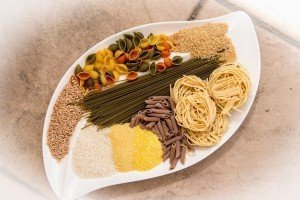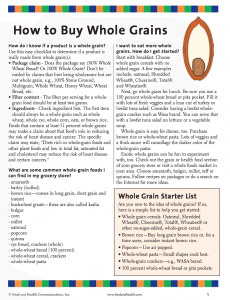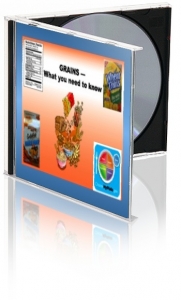Shopping for Whole Grains: A Guide
 Whole grains have been all over the news lately. They're now required in many school lunch programs, and people are encouraged to incorporate whole grains into daily meals and snacks.By now, your clients have probably heard all about the health benefits of whole grains. Most of them may even have great reasons for incorporating more whole grains into their diets (staving off chronic disease, improving cholesterol, etc). But sometimes, knowledge about why a food is healthful isn't quite enough. How to start eating more of these whole grain foods is also key.After all, if people don't know how to find and use whole grains, then their understanding of grains' health benefits may be a bit less useful.
Whole grains have been all over the news lately. They're now required in many school lunch programs, and people are encouraged to incorporate whole grains into daily meals and snacks.By now, your clients have probably heard all about the health benefits of whole grains. Most of them may even have great reasons for incorporating more whole grains into their diets (staving off chronic disease, improving cholesterol, etc). But sometimes, knowledge about why a food is healthful isn't quite enough. How to start eating more of these whole grain foods is also key.After all, if people don't know how to find and use whole grains, then their understanding of grains' health benefits may be a bit less useful.
- Package claim: Does the package say 100% Whole Wheat Bread? Or 100% Whole Grain? Don’t be misled by claims that hint at being wholesome but aren't actually backed up. 100% Stone Ground, Multigrain, Whole Wheat, Honey Wheat, Wheat Bread, etc are not necessarily 100% whole grain foods. Be sure to check the package closely.
- Fiber content: The fiber content also offers insight into whether a food is truly made with whole grains. The amount of fiber per serving of a whole-grain food should be at least two grams.
- Ingredients: Check the ingredient lists! In whole grain foods, the first item should always be a whole grain. Think whole wheat, whole rye, whole corn, oats, or brown rice.
Foods that contain at least 51 percent whole grains may make a claim about that food's role in reducing the risk of heart disease and cancer. The specific claim may state, "Diets rich in whole-grain foods and other plant foods and low in total fat, saturated fat and cholesterol may reduce the risk of heart disease and certain cancers."
 What are some common whole-grain foods that I can find in my grocery store?
What are some common whole-grain foods that I can find in my grocery store?
- Amaranth
- Barley (hulled)
- Brown rice (there are many varieties -- choose from long grain, short grain, and instant)
- Buckwheat groats (a.k.a. kasha)
- Bulgur
- Corn
- Millet
- Oatmeal
- Popcorn
- Quinoa
- Whole-wheat bread, cereal, or crackers
- Whole-wheat pasta
- Whole grain cereals: Oatmeal, Shredded Wheat®, Cheerios®, Total®, Wheaties® or other no-sugar-added, whole-grain cereal
- Brown rice: Buy long grain brown rice or, for a time saver, consider instant brown rice
- Popcorn: Use air popped
- Whole-wheat pasta: Small shapes cook best
- Whole-grain crackers: e.g. WASA brand
- 100 percent whole-wheat bread or pita pockets
Like what you see? Get the handout for free! But wait, there's more! Take a look at these great resources...
But wait, there's more! Take a look at these great resources...




